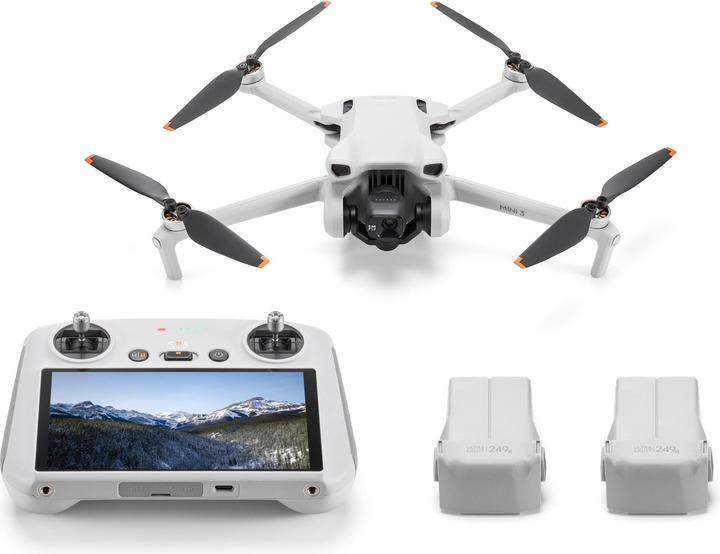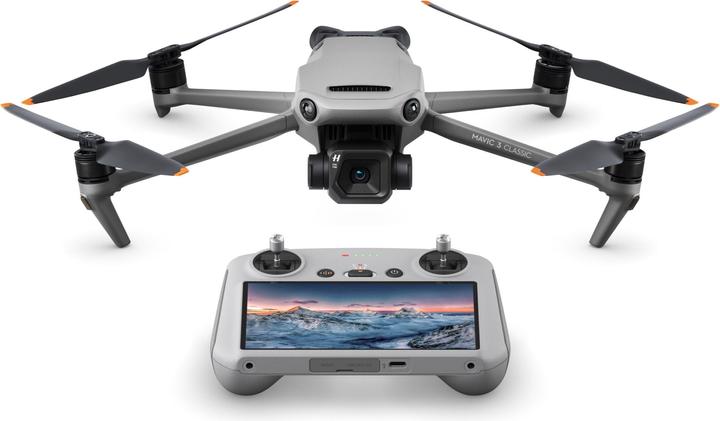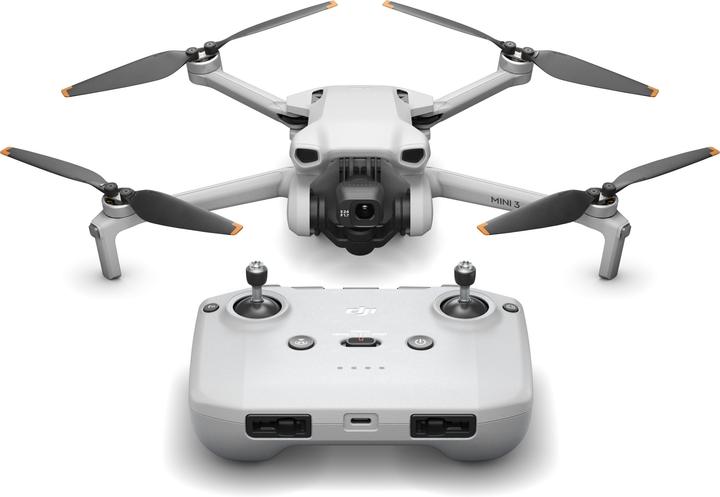
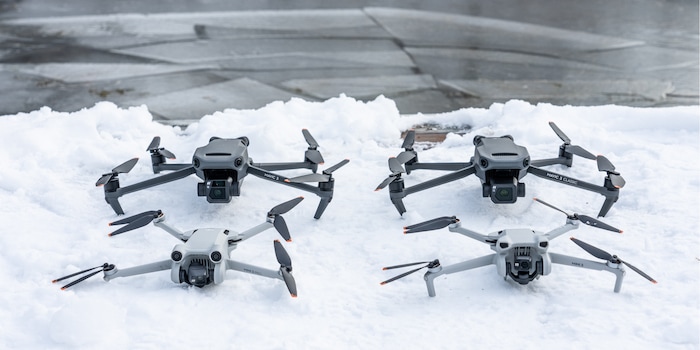
Mavic 3 Classic and Mini 3: where DJI’s budget drones hit the mark
In the last two months, DJI has released low-priced versions of the little Mini and the big Mavic. The comparison test with the original version of the drones shows that they’re not bad, but they’re also not necessary.
DJI’s drone range is a jungle. This Chinese company offers devices in almost every price bracket and size. Enter the latest fad: light, pared-down versions of the «Pro» models for a slightly smaller price tag. The DJI Mavic 3 Classic is a budget edition of the DJI Mavic 3, while the DJI Mini 3 is a cheaper variety of the DJI Mini 3 Pro. I could get myself into a lather penning a whole article on the naming structure, which seems both illogical and arbitrary. Instead, I test both budget drones in tandem with their big sisters. Spoiler alert: I’d recommend one, but not the other.

Source: Samuel Buchmann
DJI Mini 3: obvious downsides
First off, I take a look at the latest arrival to the DJI line-up – the Mini 3. With the standard controller (and no accessories), it comes in at 600 francs or 580 euros. That’s 300 francs or 250 euros less than the Mini 3 Pro. You make less of a saving if you add on bundles with additional batteries or RC remote control. The Mini 3 boasts its own display and works without a mobile phone, which I find incredibly practical. But what are you missing out on if you opt for this budget drone for the sake of your wallet?
Image quality: same sensor, worse formats
Let’s start with the good news. The low-priced Mini 3 inherits the 1/1.3-inch sensor and high-speed f/1.7 lens with its 24 mm focal length from the Pro model. As a result, the 248-gramme drone takes good pictures and videos. When the light conditions aren’t good, the shots don’t show any more image noise than on the larger models. That’s because the Mini doesn’t need to crank up the ISO, thanks to its large aperture. In terms of filming, the Mini 3 can achieve up to 30 frames per second (fps) in 4K as well as 8 bit. The photos have a resolution of 12 megapixels.
These values are worse than on the Mini 3 Pro. It, in turn, can shoot 4K video at 60 fps and boasts a high-res mode for stills with 48 megapixels. However, the bigger issues for me when it comes to the new budget drone are the limited colour profile and file formats. While the Pro D-Cinelike dominates with its 10-bit colour depth and better H.265 compression, the Mini 3 is lacking in both. If you want to edit your videos on the computer, you’re at a serious disadvantage. This budget drone can also take photos in RAW format.
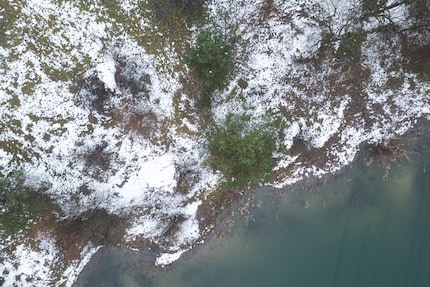
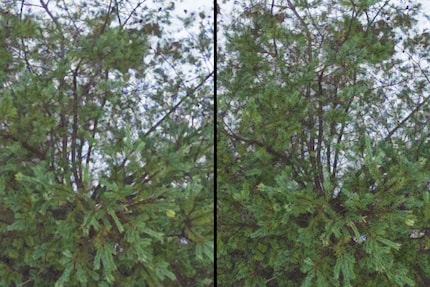
Source: Samuel Buchmann
Sure, a large part of the target audience isn’t interested in grading videos on their computer and just wants the best possible shots with the least effort. And for that, the standard colour profile does the job. But I can even tell the difference between the budget model and more expensive Pro with my test shots in this standard setting. If I look at the clip from the video above that’s been magnified by 800%, I can still easily read the text on the Mini Pro 3; but on the lower-priced Mini 3, I can hardly make it out. That’s pixel peeping at work. But even in practice, the drone struggles more to resolve fine details, such as branches. I’d surmise that’s down to a weaker image processor or poorer compression.
Features: take a look for yourself
You also have to lower your sights when it comes to obstacle detection. The Mini 3 only has one at the bottom – and it’s not even particularly reliably when I put it to the test. For me, that’s a big problem for a beginner drone. The Pro, on the other hand, has efficient sensors on the bottom, front and back. So, if you want to save yourself 300 francs, you have to be more experienced at flying drones or look for surroundings without any obstacles. Then there’s the fact the budget drone only transfers the image signal to the controller in 720p. The Pro manages it at 1080p. This doesn’t have an impact on the image quality of your shots, but it does mean flying isn’t as fun.
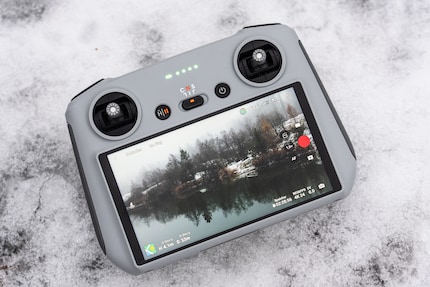
Source: Samuel Buchmann
I look for tracking features to no avail. The only thing the Mini 3 can do is a few quick shots, such as Dronie or Helix mode. But even they look quite shaky when I give it a go. I’ll blame it on the presumably weak processor and missing sensors. Meanwhile, the Mini 3 Pro also dominates the new MasterShots and can automatically follow people or cars.
The rest: looks good to me
Apart from the two big differences, the Mini 3 delivers the same solid performance as its older sibling. Flying is as easy as ever. Both drones manage to do around 40 km/hr in Sport mode and, realistically, stay in the air for about half an hour. I reckon those are very respectable values for a drone of this size. What’s more, the signal transmits reliably with the RC remote control, and the range is more than sufficient.
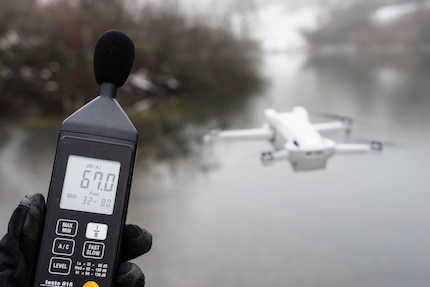
Source: Samuel Buchmann
The positive thing that struck me about both versions of the small drone is that they’re quiet. At a distance of 30 centimetres, I measured 67 decibels. To put this into perspective: the big Mavic 3 registers about 10 decibels more. As soon as the Mini 3 is a bit further away, it’s remarkably quiet and a lot less of a disturbance for people around you than other drones.
DJI Mavic 3 Classic: skimps in the right place
The Mavic 3 isn’t louder for nothing. Compared with the Mini, it’s a massive device. From November 2022, you’ve now been able to get your hands on a budget version of DJI’s biggest collapsible drone. The Mavic 3 Classic will set you back 1,700 francs or 1,600 euros. In Switzerland, there’s not much difference in price with the original Mavic 3, as the latter has dropped in price since this new release. The price saving is only 170 francs. In Germany, however, you get to keep an extra 330 euros in your pocket. It’s to be expected that the price gap will also stretch to 300 francs in Switzerland within a few months. You can buy the Classic in a bundle with RC remote control, but not as a Fly More combo. With the more expensive version, it’s exactly the opposite. But why is that the case? No idea.
Image quality: just as good
Compared with the Mini, the cheaper version of the Mavic 3 doesn’t lower its standards when it comes to image quality. As with the original, the Classic films in 5.1K at up to 50 fps and in 4K with as much as 120 fps – both also in H.265 Codec and either HLG- or D-Log colour profile. The latter is flatter than the D-Cinelike profile on the Mini Pro and contains the most details in dark and light areas, especially in high-contrast scenes. What’s more, it doesn’t oversharpen images as much as the standard colour profile. If you want that effect, you have to spend some time afterwards grading videos on the computer. But, in my opinion, it’s worth the effort. For me, the D-log colour profile would be one of the main reasons for buying a Mavic rather than a smaller drone. I particularly like the following solution. You can record in low-contrast D-log but show a regular colour profile on the controller. That way, you can still properly assess the lighting.
Even with photos, there’s no difference between the two big juggernauts. Both deliver 20 megapixels in JPG or RAW. The 4/3-inch sensor ensures good dynamic range. Likewise, noise performance is decent, especially when compared to other drones. But don’t expect any miracles, as ISO values beyond 800 don’t look that great any more. Furthermore, the 24-mm lens is not beyond doubt, despite the fact the camera module flaunts the Hasselblad logo. It resolves very fine details in the middle of the image, but at the edges, the definition drops significantly. The aperture is variable, which is helpful especially with footage. However, I wouldn’t use it at less than f/7, because you then get diffraction blur.
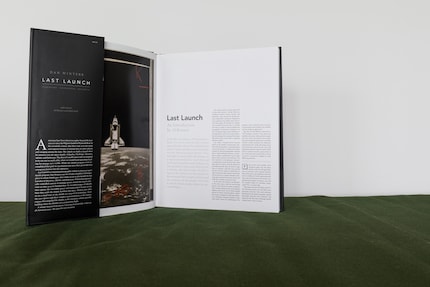
Source: Samuel Buchmann
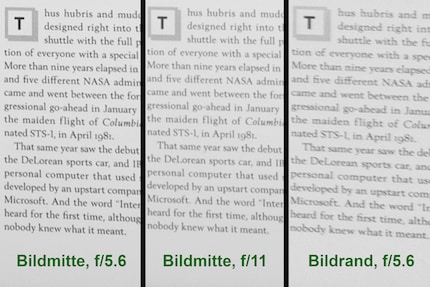
Source: Samuel Buchmann
Features: no telephoto, but it has a C1 classification
The only thing missing with the Mavic 3 Classic is the telephoto lens. Alongside the main camera, the original version showcases a second with a 1/2-inch sensor and 162 mm focal length. But that’s more of a gimmick. For a start, its image quality is considerably worse than that of the main camera. The telephoto lens has a fixed f/4.4 aperture, and I can’t film in the D-log colour profile. As you can see in the video below, the focus doesn’t leave anything to be desired. Secondly, the field of view is too narrow for most applications. Which is a shame, as I often film climbing scenes, where another lens would certainly be handy rather than always having the same wide-angle. But what would be more sensible is something in the 50 mm range. The optical 7 × magnification on the Mavic 3 is way too much for me. And the digital enlargement to 28 × is only suitable for the likes of spies.
But I can manage without this feature. Apart from that, the Classic has absolutely no downsides. Its obstacle detection is excellent, and it has sensors in all directions – even sideways and above. For me, that’s invaluable when I’m flying a drone near trees. My own personal Air 2, which has fewer sensors, has made the acquaintance of branches on numerous occasions. Apart from that, DJI has treated the Classic to all the automatic modes, such as MasterShots and the latest object tracking.
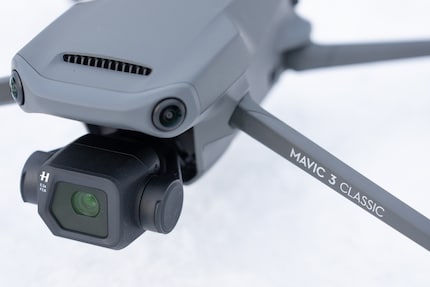
Source: Samuel Buchmann
The first drone to get a C1 classification is the ex-factory Classic. This will be relevant by 2024 at the latest. That’s when the transition period for the new drone law will come to an end – it begins on 1 January 2023 in Switzerland. As part of this legislation, drones over 250 grammes without a classification will be subject to much more stringent restrictions after the transition period. The Mavic 3 Classic, on the other hand, is future-proof and can still be flown as a category A1. You can find out more about exactly what that means on the FOCA website.
The rest: state of the art
Because of its size, the Mavic 3 Classic needs a lot of power. Fortunately, the battery is sized accordingly and has a run time of 40 minutes. This means the drone can fly at 60 km/hr and has huge reserves in terms of range thanks to DJI’s transmission system O3+. While the Mavic does make a lot more noise than the Mini, it’s not deafening. For a device of this size, I’d say the sound level is alright. All in all, the Mavic 3 Classic’s performance simply can’t be faulted. The only downsides are its price, weight and size.
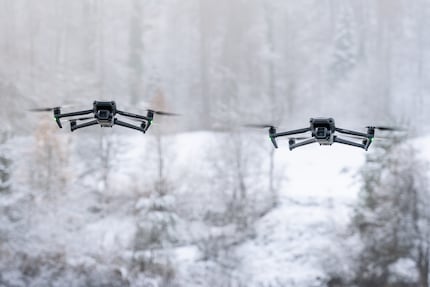
Source: Samuel Buchmann
Verdict: OK, but is it really necessary?
Neither of the two new budget drones are bad. The sales price of the Mini 3 and the Mavic 3 Classic ensures they slot into the range in the right order. If you opt for the new budget Mini, however, you have to accept certain sacrifices compared with the Pro version. Even though the sensor is the same, the available video formats limit its image quality. For me, what’s worse is the almost non-existent obstacle detection. In my opinion, DJI is saving on the wrong thing. So if you want a small drone, I’d still recommend the Mini 3 Pro. Especially if you snap it up in a bundle, then it’s worth the premium. And if you have a really small budget, I’d suggest you opt instead for the older Mini 2. As part of the Fly More Combo, it’s a real bargain.
Conversely, I’m scrapping my recommendation for the Mavic. The new Classic only dispenses with the telephoto lens, which isn’t very useful in any case. Apart from that, it offers the same excellent image quality and the same good flight characteristics as the original Mavic 3. So, I’d save myself the additional cost. That being said, the price difference at the time of writing is still very slight, as the Classic is fresh on the market. If you’re able to wait, a bit of patience should be worth it.
What with such slight differences to set the different models apart, the question is, do we really need the additional versions? The answer is no, I don’t think so. The staggering speed with which DJI hurls drones onto the market is of no benefit to customers. Rather, it has the effect of frustrating the target market, as they lose track of things. And they also permanently feel as though another better or cheaper model will come along in no time. The high frequency of device releases only serves for marketing purposes. Because every new drone brings media exposure in the form of tests, just like this one. So, meet you back here for the next DGI review?

Source: Samuel Buchmann
FYI: The EU drone law will come into force in 2023, even in Switzerland. In future, drones will need a classification. But next year (2023) is still considered a transitional period. The Mavic 3 Classic is the first drone to be shipped with a C1 classification straight out of the box. For Mavic 3s, you can apply for a C1 classification retrospectively. However, that doesn’t work for Swiss devices at the moment. It’s to be expected that this will change soon. Meanwhile, you can continue to fly drones under 250 grammes, such as the Mini 3, in the category A1 even after the transition period without limitation. You can find out more about this in an article from my colleague David Lee.
My fingerprint often changes so drastically that my MacBook doesn't recognise it anymore. The reason? If I'm not clinging to a monitor or camera, I'm probably clinging to a rockface by the tips of my fingers.
